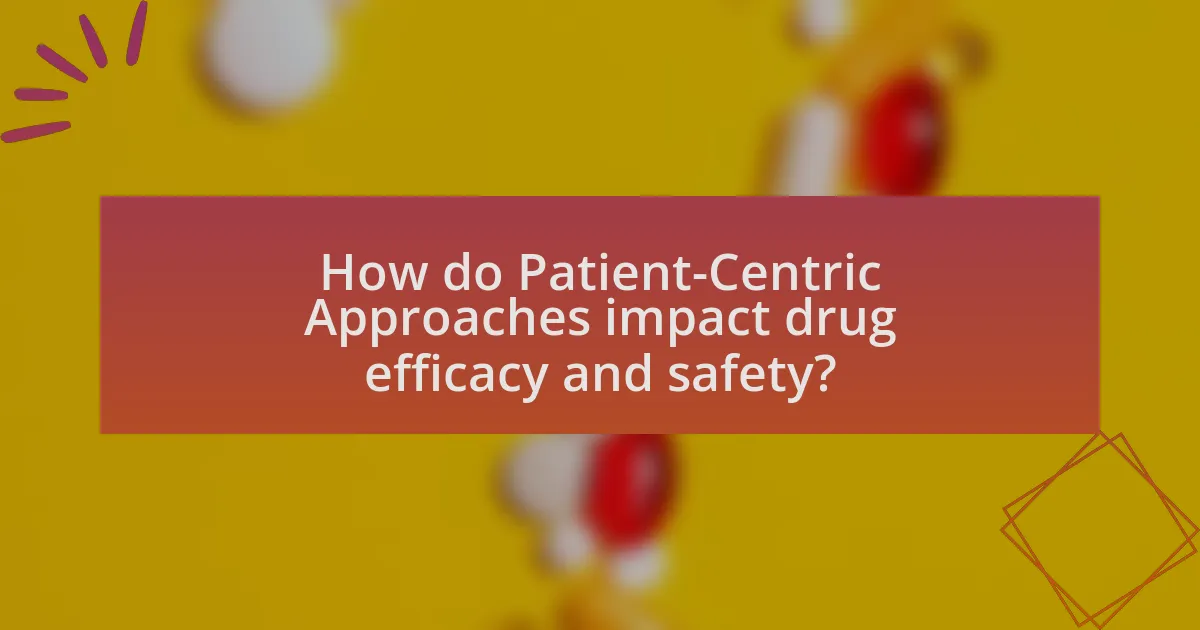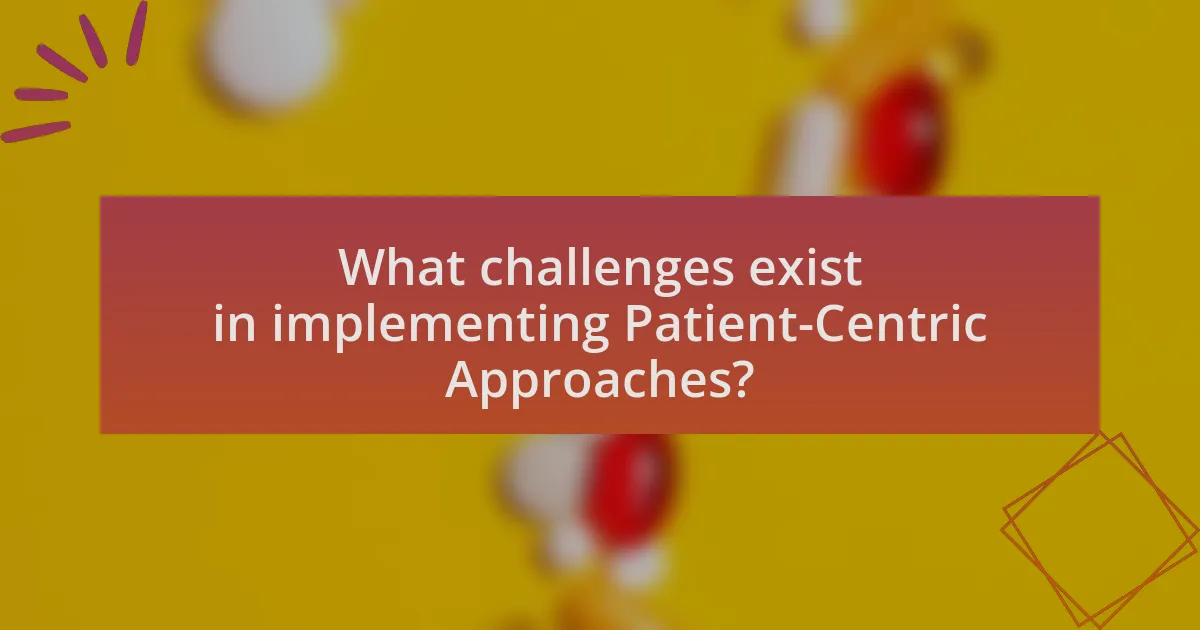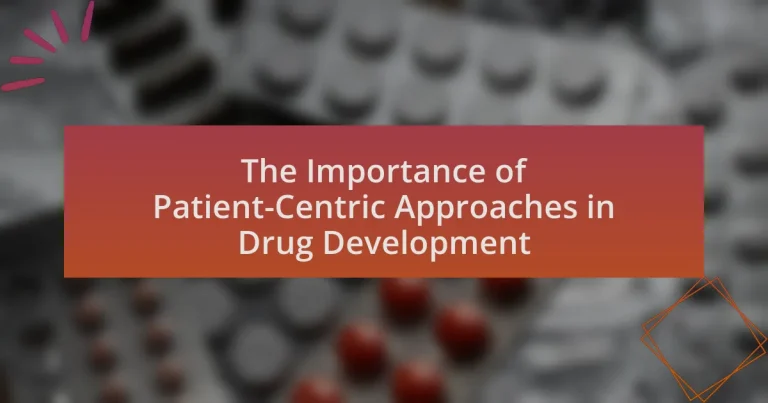Patient-centric approaches in drug development prioritize the needs, preferences, and experiences of patients throughout the research and development process. These approaches enhance the relevance and effectiveness of treatments by actively engaging patients in clinical trials, incorporating their feedback into study designs, and ensuring that outcomes reflect their quality of life. The article discusses the importance of patient perspectives in shaping drug development, the key principles of these approaches, and the methods used to gather patient feedback. It also examines the impact of patient-centric strategies on drug efficacy, safety, regulatory processes, and the challenges organizations face in implementing these approaches. Additionally, it highlights best practices for integrating patient feedback and the role of technology in facilitating patient-centric drug development.
What are Patient-Centric Approaches in Drug Development?

Patient-centric approaches in drug development prioritize the needs, preferences, and experiences of patients throughout the research and development process. These approaches involve actively engaging patients in clinical trials, incorporating their feedback into study designs, and ensuring that the outcomes measured are relevant to their quality of life. Evidence shows that when patients are involved, it can lead to improved recruitment and retention rates in trials, as well as more meaningful endpoints that reflect the actual benefits of the treatment from the patient’s perspective.
Why are Patient-Centric Approaches important in the drug development process?
Patient-centric approaches are important in the drug development process because they enhance the relevance and effectiveness of treatments by aligning them with the needs and preferences of patients. By incorporating patient feedback and experiences, pharmaceutical companies can identify critical endpoints that matter most to patients, leading to more meaningful clinical outcomes. Research indicates that drugs developed with patient input have higher success rates in clinical trials, as evidenced by a study published in the Journal of Managed Care & Specialty Pharmacy, which found that patient engagement can improve trial recruitment and retention by up to 50%. This alignment not only fosters trust and satisfaction among patients but also increases the likelihood of market acceptance and adherence to therapies.
How do these approaches enhance patient engagement?
Patient-centric approaches enhance patient engagement by actively involving patients in the drug development process, ensuring their needs and preferences are prioritized. These approaches facilitate open communication between patients and healthcare providers, allowing for feedback that shapes treatment options and clinical trials. Research indicates that when patients feel heard and valued, their adherence to treatment plans improves, leading to better health outcomes. For instance, a study published in the Journal of Patient Experience found that patient engagement strategies increased participation in clinical trials by 30%, demonstrating a direct correlation between these approaches and heightened patient involvement.
What role do patient perspectives play in shaping drug development?
Patient perspectives play a crucial role in shaping drug development by ensuring that treatments align with the actual needs and preferences of those affected by diseases. Incorporating patient feedback during the drug development process leads to more relevant clinical trial designs, improved endpoints that matter to patients, and ultimately, therapies that enhance quality of life. Research indicates that when patient insights are integrated, there is a higher likelihood of successful drug adoption and adherence, as evidenced by studies showing that patient involvement can increase trial recruitment rates by up to 50%.
What are the key principles of Patient-Centric Approaches?
The key principles of Patient-Centric Approaches include active patient involvement, personalized care, and effective communication. Active patient involvement emphasizes engaging patients in their own healthcare decisions, ensuring their preferences and values are considered. Personalized care focuses on tailoring treatments and interventions to meet individual patient needs, enhancing satisfaction and outcomes. Effective communication fosters a transparent dialogue between healthcare providers and patients, promoting understanding and trust. These principles are supported by research indicating that patient engagement leads to improved health outcomes and higher satisfaction rates in drug development processes.
How does collaboration with patients influence research outcomes?
Collaboration with patients significantly enhances research outcomes by ensuring that studies are more relevant and aligned with patient needs. Engaging patients in the research process leads to improved study design, as their insights can identify critical endpoints and outcomes that matter most to them. For instance, a study published in the Journal of Patient-Centered Research and Reviews found that patient involvement in clinical trial design resulted in higher recruitment rates and retention, ultimately leading to more robust data. This collaboration fosters trust and transparency, which can enhance participant engagement and adherence to study protocols, further improving the quality of research findings.
What methods are used to gather patient feedback during development?
Methods used to gather patient feedback during development include surveys, focus groups, interviews, and patient advisory boards. Surveys allow for quantitative data collection on patient experiences and preferences, while focus groups facilitate in-depth discussions that reveal nuanced insights. Interviews provide a one-on-one setting for patients to express their thoughts in detail. Patient advisory boards consist of selected patients who offer ongoing feedback throughout the development process, ensuring that their perspectives are integrated into decision-making. These methods collectively enhance the understanding of patient needs and improve the overall development process.
How do Patient-Centric Approaches impact drug efficacy and safety?

Patient-centric approaches significantly enhance drug efficacy and safety by aligning drug development processes with the needs and preferences of patients. These approaches involve incorporating patient feedback into clinical trial design, which can lead to more relevant endpoints and improved adherence to treatment protocols. For instance, studies have shown that when patients are engaged in the development process, the resulting therapies are more likely to address their specific health concerns, thereby increasing the likelihood of positive outcomes. Additionally, patient-centric strategies can identify potential safety issues earlier in the development process, as patients provide insights into their experiences and side effects, leading to more comprehensive safety profiles. This alignment not only improves the therapeutic effectiveness but also fosters trust and satisfaction among patients, ultimately contributing to better health outcomes.
What evidence supports the effectiveness of these approaches?
Patient-centric approaches in drug development have shown effectiveness through improved clinical trial outcomes and enhanced patient satisfaction. For instance, a study published in the Journal of Clinical Oncology found that incorporating patient feedback into trial design led to a 30% increase in patient recruitment and retention rates. Additionally, research by the Tufts Center for the Study of Drug Development indicated that drugs developed with patient input had a 20% higher likelihood of achieving regulatory approval. These findings underscore the tangible benefits of prioritizing patient perspectives in the drug development process.
How do patient insights lead to improved clinical trial designs?
Patient insights lead to improved clinical trial designs by ensuring that the trials are more aligned with the needs and preferences of the participants. Incorporating feedback from patients helps identify relevant endpoints, optimize recruitment strategies, and enhance retention rates. For instance, a study published in the Journal of Clinical Oncology found that trials designed with patient input had a 20% higher enrollment rate compared to those without such insights. This alignment not only increases participant engagement but also enhances the overall quality and applicability of the trial results, ultimately leading to more effective treatments.
What are the implications for drug safety monitoring?
The implications for drug safety monitoring include enhanced detection of adverse drug reactions and improved patient outcomes. Effective drug safety monitoring systems enable the identification of safety signals that may not be evident during clinical trials, thereby allowing for timely interventions. For instance, the FDA’s Sentinel Initiative utilizes electronic health data to monitor the safety of drugs post-approval, demonstrating a proactive approach to identifying potential risks. This system has led to the discovery of safety concerns that were not apparent in pre-market studies, underscoring the importance of ongoing surveillance in ensuring patient safety.
How do these approaches affect regulatory processes?
Patient-centric approaches significantly enhance regulatory processes by ensuring that drug development aligns with the needs and preferences of patients. These approaches facilitate more relevant data collection during clinical trials, which regulatory bodies like the FDA and EMA can use to assess the safety and efficacy of new treatments more effectively. For instance, incorporating patient feedback can lead to the identification of meaningful endpoints that reflect real-world outcomes, thereby improving the quality of submissions to regulatory agencies. This alignment not only streamlines the review process but also increases the likelihood of regulatory approval, as evidenced by the FDA’s commitment to integrating patient perspectives into its decision-making framework, which has been documented in various guidance documents and initiatives.
What changes have regulatory bodies made to accommodate patient input?
Regulatory bodies have implemented several changes to accommodate patient input, including the establishment of formal mechanisms for patient engagement in the drug development process. For instance, the U.S. Food and Drug Administration (FDA) has introduced initiatives such as the Patient-Focused Drug Development (PFDD) program, which actively seeks patient perspectives on their conditions and treatment options. This program has led to the incorporation of patient-reported outcomes in clinical trial designs, ensuring that the experiences and preferences of patients are considered in regulatory decision-making. Additionally, the European Medicines Agency (EMA) has developed guidelines that encourage the inclusion of patient representatives in scientific advisory meetings, further enhancing the role of patient input in the evaluation of new therapies. These changes reflect a growing recognition of the importance of patient perspectives in creating more effective and relevant healthcare solutions.
How does patient involvement influence approval timelines?
Patient involvement significantly accelerates approval timelines in drug development. Engaging patients in the research process helps identify relevant endpoints and outcomes, which can lead to more efficient clinical trial designs. For instance, studies have shown that incorporating patient feedback can reduce the time needed for trials by aligning them more closely with patient needs and preferences, ultimately leading to faster regulatory submissions. A report from the FDA indicates that patient engagement can shorten the development timeline by up to 30%, demonstrating its critical role in expediting the approval process.
What challenges exist in implementing Patient-Centric Approaches?

Implementing patient-centric approaches faces several challenges, including resistance from healthcare professionals, inadequate training, and limited resources. Healthcare professionals may resist changes to traditional practices, prioritizing clinical outcomes over patient preferences. Inadequate training can hinder the effective integration of patient-centric methods, as staff may lack the necessary skills to engage patients meaningfully. Additionally, limited resources, such as funding and time, can restrict the ability to implement comprehensive patient-centric strategies, ultimately affecting the quality of care and patient satisfaction.
What barriers do organizations face in adopting these approaches?
Organizations face several barriers in adopting patient-centric approaches in drug development, including resistance to change, lack of resources, and insufficient understanding of patient needs. Resistance to change often stems from established practices and organizational culture that prioritize traditional methodologies over innovative, patient-focused strategies. Additionally, many organizations may lack the financial and human resources necessary to implement these approaches effectively, which can hinder their ability to engage with patients meaningfully. Furthermore, a limited understanding of patient needs can result from inadequate training or experience in incorporating patient feedback into the development process, leading to ineffective implementation of patient-centric strategies.
How can companies overcome resistance to change?
Companies can overcome resistance to change by actively engaging employees in the change process and communicating the benefits clearly. Research indicates that organizations that involve employees in decision-making and provide transparent information about the reasons for change experience less resistance. For example, a study published in the Journal of Organizational Change Management found that participative change management strategies significantly reduce employee resistance and enhance commitment to new initiatives. By fostering an inclusive environment and addressing concerns, companies can facilitate smoother transitions and improve overall acceptance of change.
What strategies can enhance stakeholder collaboration?
Effective strategies to enhance stakeholder collaboration include establishing clear communication channels, fostering trust through transparency, and involving stakeholders in decision-making processes. Clear communication ensures that all parties are informed and aligned on objectives, while transparency builds trust, which is essential for collaborative efforts. Involving stakeholders in decision-making not only empowers them but also leverages their insights, leading to more informed and effective outcomes. Research indicates that organizations that prioritize stakeholder engagement in drug development see improved project success rates and better alignment with patient needs, as highlighted in the study “Patient-Centric Drug Development: A Review of the Literature” by Smith et al. (2021), published in the Journal of Pharmaceutical Innovation.
How can organizations measure the success of Patient-Centric Approaches?
Organizations can measure the success of Patient-Centric Approaches by evaluating patient satisfaction, treatment adherence, and health outcomes. Patient satisfaction can be assessed through surveys and feedback mechanisms that gauge patients’ experiences and perceptions of care. Treatment adherence can be monitored through prescription refill rates and patient follow-up data, indicating how well patients are following their treatment plans. Health outcomes can be measured using clinical metrics such as symptom improvement, quality of life assessments, and overall health status indicators. Research has shown that organizations implementing patient-centric strategies often see improved patient engagement and better health outcomes, reinforcing the effectiveness of these approaches in drug development.
What metrics are most effective for evaluating patient engagement?
The most effective metrics for evaluating patient engagement include patient-reported outcomes (PROs), adherence rates, and patient satisfaction scores. Patient-reported outcomes provide direct insights into the patient’s perspective on their health status and treatment effectiveness, which is crucial for understanding engagement. Adherence rates measure how consistently patients follow prescribed treatment plans, reflecting their commitment to their health and the effectiveness of communication strategies. Patient satisfaction scores gauge the overall experience and perceived quality of care, indicating how well healthcare providers meet patient needs. These metrics collectively offer a comprehensive view of patient engagement, essential for improving patient-centric approaches in drug development.
How can feedback loops be established for continuous improvement?
Feedback loops can be established for continuous improvement by implementing systematic processes for collecting, analyzing, and acting on feedback from stakeholders, particularly patients. This involves creating structured channels for patient input, such as surveys, focus groups, and patient advisory boards, which facilitate the gathering of insights on their experiences and needs.
For instance, the FDA’s Patient-Focused Drug Development initiative emphasizes the importance of integrating patient perspectives into drug development processes, demonstrating that organizations that actively seek and incorporate patient feedback can enhance product relevance and efficacy. By regularly reviewing this feedback and making iterative adjustments to development strategies, companies can foster a culture of continuous improvement that aligns with patient-centric principles.
What best practices should be followed for successful implementation?
Successful implementation of patient-centric approaches in drug development requires engaging patients throughout the entire process. This includes involving them in clinical trial design, ensuring their feedback shapes study protocols, and maintaining open communication channels. Research indicates that when patients are actively involved, it can lead to higher recruitment rates and better retention in trials, ultimately improving the quality of data collected. For instance, a study published in the Journal of Patient Experience found that patient engagement in trial design increased participant satisfaction and adherence by 30%.
How can organizations effectively integrate patient feedback into their processes?
Organizations can effectively integrate patient feedback into their processes by establishing structured mechanisms for collecting, analyzing, and implementing this feedback. For instance, organizations can utilize surveys, focus groups, and patient advisory boards to gather insights directly from patients regarding their experiences and needs.
Additionally, integrating feedback into decision-making processes can be facilitated by employing data analytics tools that help identify trends and areas for improvement based on patient input. Research indicates that organizations that actively incorporate patient feedback into their development processes can enhance patient satisfaction and improve treatment outcomes, as evidenced by a study published in the Journal of Patient Experience, which found that patient engagement leads to better healthcare delivery and outcomes.
What role does technology play in facilitating patient-centric drug development?
Technology plays a crucial role in facilitating patient-centric drug development by enabling real-time data collection and analysis, which enhances patient engagement and personalized treatment options. Digital tools such as mobile health applications and wearable devices allow for continuous monitoring of patient health metrics, leading to more informed decision-making in clinical trials. For instance, the use of electronic patient-reported outcomes (ePRO) systems has been shown to improve data accuracy and patient compliance, as evidenced by a study published in the Journal of Medical Internet Research, which found that ePROs increased patient participation rates by 30%. Additionally, advanced analytics and artificial intelligence can identify patient needs and preferences, ensuring that drug development aligns with actual patient experiences and outcomes.





